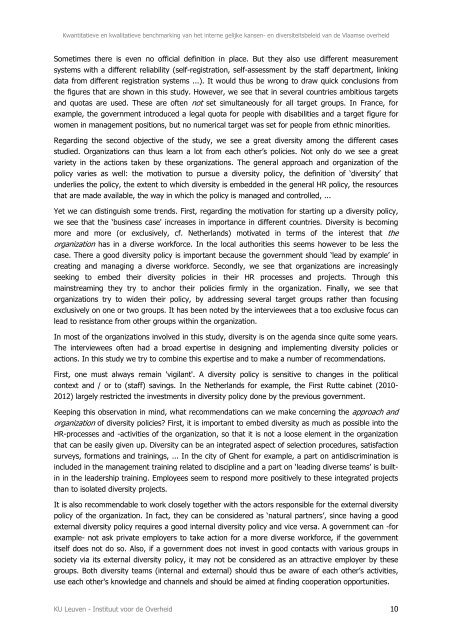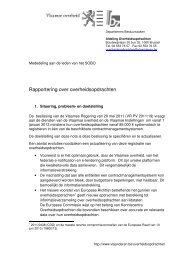Lees hier het rapport van deze kwantitatieve en ... - Bestuurszaken
Lees hier het rapport van deze kwantitatieve en ... - Bestuurszaken
Lees hier het rapport van deze kwantitatieve en ... - Bestuurszaken
You also want an ePaper? Increase the reach of your titles
YUMPU automatically turns print PDFs into web optimized ePapers that Google loves.
Kwantitatieve <strong>en</strong> kwalitatieve b<strong>en</strong>chmarking <strong>van</strong> <strong>het</strong> interne gelijke kans<strong>en</strong>- <strong>en</strong> diversiteitsbeleid <strong>van</strong> de Vlaamse overheid<br />
Sometimes there is ev<strong>en</strong> no official definition in place. But they also use differ<strong>en</strong>t measurem<strong>en</strong>t<br />
systems with a differ<strong>en</strong>t reliability (self-registration, self-assessm<strong>en</strong>t by the staff departm<strong>en</strong>t, linking<br />
data from differ<strong>en</strong>t registration systems ...). It would thus be wrong to draw quick conclusions from<br />
the figures that are shown in this study. However, we see that in several countries ambitious targets<br />
and quotas are used. These are oft<strong>en</strong> not set simultaneously for all target groups. In France, for<br />
example, the governm<strong>en</strong>t introduced a legal quota for people with disabilities and a target figure for<br />
wom<strong>en</strong> in managem<strong>en</strong>t positions, but no numerical target was set for people from ethnic minorities.<br />
Regarding the second objective of the study, we see a great diversity among the differ<strong>en</strong>t cases<br />
studied. Organizations can thus learn a lot from each other’s policies. Not only do we see a great<br />
variety in the actions tak<strong>en</strong> by these organizations. The g<strong>en</strong>eral approach and organization of the<br />
policy varies as well: the motivation to pursue a diversity policy, the definition of ‘diversity’ that<br />
underlies the policy, the ext<strong>en</strong>t to which diversity is embedded in the g<strong>en</strong>eral HR policy, the resources<br />
that are made available, the way in which the policy is managed and controlled, ...<br />
Yet we can distinguish some tr<strong>en</strong>ds. First, regarding the motivation for starting up a diversity policy,<br />
we see that the ‘business case' increases in importance in differ<strong>en</strong>t countries. Diversity is becoming<br />
more and more (or exclusively, cf. Netherlands) motivated in terms of the interest that the<br />
organization has in a diverse workforce. In the local authorities this seems however to be less the<br />
case. There a good diversity policy is important because the governm<strong>en</strong>t should ‘lead by example’ in<br />
creating and managing a diverse workforce. Secondly, we see that organizations are increasingly<br />
seeking to embed their diversity policies in their HR processes and projects. Through this<br />
mainstreaming they try to anchor their policies firmly in the organization. Finally, we see that<br />
organizations try to wid<strong>en</strong> their policy, by addressing several target groups rather than focusing<br />
exclusively on one or two groups. It has be<strong>en</strong> noted by the interviewees that a too exclusive focus can<br />
lead to resistance from other groups within the organization.<br />
In most of the organizations involved in this study, diversity is on the ag<strong>en</strong>da since quite some years.<br />
The interviewees oft<strong>en</strong> had a broad expertise in designing and implem<strong>en</strong>ting diversity policies or<br />
actions. In this study we try to combine this expertise and to make a number of recomm<strong>en</strong>dations.<br />
First, one must always remain 'vigilant'. A diversity policy is s<strong>en</strong>sitive to changes in the political<br />
context and / or to (staff) savings. In the Netherlands for example, the First Rutte cabinet (2010-<br />
2012) largely restricted the investm<strong>en</strong>ts in diversity policy done by the previous governm<strong>en</strong>t.<br />
Keeping this observation in mind, what recomm<strong>en</strong>dations can we make concerning the approach and<br />
organization of diversity policies? First, it is important to embed diversity as much as possible into the<br />
HR-processes and -activities of the organization, so that it is not a loose elem<strong>en</strong>t in the organization<br />
that can be easily giv<strong>en</strong> up. Diversity can be an integrated aspect of selection procedures, satisfaction<br />
surveys, formations and trainings, ... In the city of Gh<strong>en</strong>t for example, a part on antidiscrimination is<br />
included in the managem<strong>en</strong>t training related to discipline and a part on ‘leading diverse teams’ is built-<br />
in in the leadership training. Employees seem to respond more positively to these integrated projects<br />
than to isolated diversity projects.<br />
It is also recomm<strong>en</strong>dable to work closely together with the actors responsible for the external diversity<br />
policy of the organization. In fact, they can be considered as ‘natural partners’, since having a good<br />
external diversity policy requires a good internal diversity policy and vice versa. A governm<strong>en</strong>t can -for<br />
example- not ask private employers to take action for a more diverse workforce, if the governm<strong>en</strong>t<br />
itself does not do so. Also, if a governm<strong>en</strong>t does not invest in good contacts with various groups in<br />
society via its external diversity policy, it may not be considered as an attractive employer by these<br />
groups. Both diversity teams (internal and external) should thus be aware of each other’s activities,<br />
use each other's knowledge and channels and should be aimed at finding cooperation opportunities.<br />
KU Leuv<strong>en</strong> - Instituut voor de Overheid 10

















